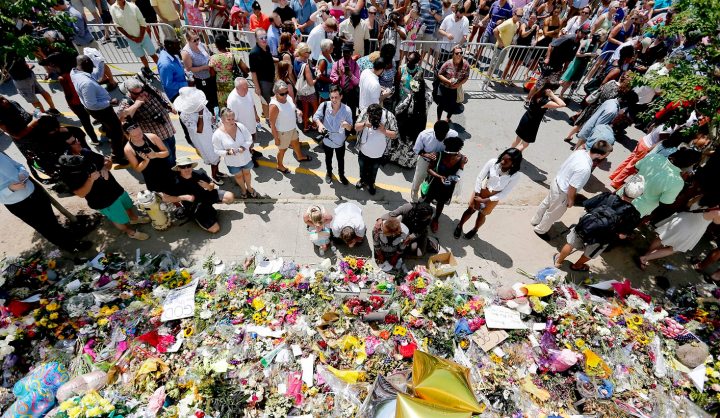World
What Devil made him do it? When Dylann Roof murdered in Charleston, South Carolina

The horrendous killing of nine people in a church Bible study class by Dylann Roof, driven by an idea of racial superiority, has left deep wounds in Charleston, South Carolina – and across the US nation. What drove him to do such a deed, and how is this tangled up with the history of Southern segregation, the role of the black church – and, of course, the easy availability of lethal force? J BROOKS SPECTOR takes an initial look.
Once again the United States is rocked by what yet another mass killer has managed to do. This time it was a twenty-one-year-old high school dropout and sometime landscape gardener in Charleston, South Carolina, Dylann Roof, who entered an historic, traditionally black church, quietly sat down for several hours during a Bible study lesson, took out a loaded pistol and then proceeded to kill nine people. Among the victims was the Rev Clementa C Pinckney, who was both the church’s pastor and a state senator.
Roof had to face the victims’ families at his bail hearing, where he was arraigned and where they offered their forgiveness. They told him that while they are in deep grief for their tragic losses, the have found it in their hearts to forgive him for this mortal transgression.
The State of South Carolina has already charged him with murder and the federal government has said it is investigating whether he can be charged for carrying out a hate crime as well. (Murder is a state and not a federal charge, but hate crimes fall under federal jurisdiction.)
The national – indeed, international – conversation over this tragedy turned quickly towards four interconnected themes, once the killer had been identified and apprehended. First was the question of just what kind of monster Roof was and what his motivations were. Second was whether there were links – somehow, somewhere – between Roof and other larger, more extensive groups. Third was the question of whether Roof’s deeds were somehow the natural extension of a larger white supremacist ethos that tied in with the continuing national agonies over race. Finally, of course, was the question, yet again, after this latest multiple killing spree, of what it would it take before Americans finally shucked off their fatal fascination with gun ownership.
It would be easy to describe Roof as a kind of particularly malignant blend of Travis Bickle of the film Taxi Driver and those “gallant” Ku Klux Klan riders in DW Griffiths’ Birth of a Nation, and the all-too-real Gary Gilmour, as profiled in Norman Mailer’s The Executioner’s Song. As self-described in the postings on a website now being ascribed to him, Roof had a whole litany of complaints about African Americans and bemoaned the lack of like-minded others who would deal decisively with that putative enemy within a white America, and so he said he was compelled to take matters into his own hands. At this point, no one knows if he had actually been in touch with others who said they were also bent on death and destruction, or if Roof’s comments on others were just the bizarre gobble that shows up in the danker spheres of social media.
Almost immediately after he had been identified as the shooter, a picture surfaced of Roof wearing a bomber jacket sporting the old South African and the Rhodesian flags on it – even though that picture quickly sparked a small controversy of its own. Right-wing websites were quick to argue that those two flags had been added onto a more anodyne picture of Roof by dark forces for their own suspicious reasons. But the contents of Roof’s own apparent website would seem to have tipped the scales.
Over the weekend, a website, reportedly created by Roof, came to light. It contained images of Roof holding a Confederate flag; Roof burning a US national flag; and Roof wearing a T-shirt bearing the number “88” – something that is white supremacist code for “Heil Hitler”. And there were yet other pictures of Roof at historical heritage sites in the South – usually connected to slavery or the Confederate cause. The death of Trayvon Martin, the Florida teenager killed by neighbourhood watch volunteer patroller George Zimmerman, seems to have especially infuriated Roof – but over the blame assigned to Zimmerman in the shooting, rather than sympathy for the dead victim.
The rather lengthy manifesto on that website attributed to Roof is now the object of intense scrutiny. It says, “I have no choice. I am not in the position to, alone, go into the ghetto and fight. I chose Charleston because it is most historic city in my state, and at one time had the highest ratio of blacks to Whites in the country. We have no skinheads, no real KKK, no one doing anything but talking on the internet. Well someone has to have the bravery to take it to the real world, and I guess that has to be me.”
The New York Times commented on this statement, saying, “If it is genuine, as his friends seem to think, the tourist sites he visited, the pictures that were posted and the hate-filled words on the site offered a chilling glimpse into the interests of an unemployed former landscaper said to have a fixation on race.”
While family, friends and acquaintances have expressed horror at his deeds, some have expressed astonishment with the image of Dylann Roof as a cold-blooded killer, motivated by fierce racial-hatred. One of them, Caleb Brown, a mixed race, childhood friend told the media, “This whole racist thing came into him within the past five years. He was never really popular; he accepted that. He wasn’t like: ‘When I grow up I am going to show all these kids’. He accepted who he was, and who he was changed, obviously.” Roof apparently only spoke once to anyone about his murder spree, merely saying he was going to do something crazy with the gun he had purchased, with money given him for his 21st birthday.
Feeding the painful loner narrative, however, his relatives were calling him a “sweet kid” who had somehow morphed into a “painfully shy” loner sucked into a sinister online universe. His ex-stepmother told broadcasters she had heard from Roof’s mother when she said, “He was locked in his room looking up bad stuff on his computer. Something on the computer drew him in — this is Internet evil.” She added he was also germ phobic and insisted on keeping the pudding bowl haircut he had had for years. “He would fixate on things. His dad tried to help him. His mother tried to help him. We all really tried to help him,” the ex-stepmother said.
And his biological mother added, “Ben comes from a very good family, very well-educated, from church-going, God-loving people who would never condone or teach this to their children. I don’t know when Dylann got lost.” A cynic might say that right here is the beginning of the story of a young man who had lost his way, fell in with wicked friends and forces and was thereby enticed into or led down the path towards acts of unbelievable evil – at the behest of others or perhaps from the recesses of his own unconscious.
Even as they were trying to make sense of what had happened to him, his family had the presence of mind to issue their statement of condolence for Roof’s acts. Their statement read, “The Roof Family would like to extend their deepest sympathies and condolences to families of the victims in Wednesday night’s shooting at the Emanuel African Methodist Episcopal Church in Charleston. Words cannot express our shock, grief, and disbelief as to what happened that night. We are devastated and saddened by what occurred. We offer our prayers sympathy for all of those impacted by these events.”
But there are obviously other issues that must be addressed besides the dark, swirling currents in Dylann Roof’s own thoughts. This event took place in a South Carolina that remains bedevilled over how to wrestle with its entire history. Or as novelist William Faulkner had said of yet another southern landscape, “The past is never dead. It’s not even past.”
South Carolina was the birthplace of the Confederacy back in the 1860s and has faced a hard political battle for decades over whether the Confederate battle flag would fly over its state capitol building. For some, obviously, this flag represents that mythic “Southern way of life”, so beloved of novelists like Margaret Mitchell of Gone with the Wind fame. But for many others, that same flag is a constant reminder of a social, economic and political order that was built on human slavery, and then by a harshly segregated society put in place after the Union occupation was came to an end in 1876 – and that only began to disintegrate in the 1960s. The current compromise that the Confederate flag will not fly over the state capitol itself, but on a flagpole close to the building has satisfied no one and would seem to represent the fractured nature of South Carolinian society in dealing with its past. (Think, perhaps, of Cecil Rhodes’ statue being moved half way down the steps at UCT, but still there?)
Going forward, the question left hanging is how Roof’s killing spree will be woven into the racial tensions in Charleston (where another young man had been killed by police some months earlier), and in the nation as a whole. Will it exacerbate future tensions as an indicator of the unresolved tensions over racial inequality, or will Roof’s murderous visit to the Emanuel African Baptist Church be accepted as a kind of one-of-a-kind incident? This is particularly sensitive point, in part because this particular church has had a long history as a bastion of African American community life in Charleston and Denmark Vesey – the executed leader of a slave rebellion back in 1822 – had been a leading member of the predecessor church to this very congregation. How Roof’s killings will be woven into the nation’s larger narrative is yet to be written.
Finally, of course, there is the place of firearms in American life. Unique among all high income, developed states, although there are some limitations in some states over the purchase and ownership of firearms, in most of America it remains obscenely easy for someone to assemble an arsenal – well beyond anything that could conceivably be useful for personal and family defence. The Second Amendment of the Constitution – “A well-regulated Militia, being necessary to the security of a free State, the right of the people to keep and bear Arms, shall not be infringed” – has been read to mean there should be no restrictions on gun ownership, rather than its more likely original intention to prevent the federal government from banning state militias to preclude national tyranny as with British rule before independence.
Back in the 18th century, with the dangers of the frontier, that may have made sense, but the country is no longer an agrarian nation of a mere 4 million people scattered over its vast landscape. However, the National Rifle Association, a private interest group, acting in tandem with social conservative and right wing political movements and many political figures, has been largely successful in preventing state bans, let alone outright federal ones, on most forms of gun ownership, or even really significant restrictions. Dylann Roof, for example, had recently been charged with trespassing and a controlled substance contravention and presumably should not have been eligible to purchase a handgun in the first place but he managed to without difficulty, it appears.
And so, like the killings at that Connecticut primary school, at Columbine High School, at the Fort Hood military base, and on back to the killings from the clock tower at the University of Texas so many years before, the country still seems positioned – so far at least – not to let this latest massacre lead to real restrictions on the ownership of lethal weapons in the hands of people like Dylann Roof – or pretty much anybody else.
As such, Americans must steel themselves for the certainty, soon enough, that yet another disaffected young man – alienated, and in the grip of an odious ideology – once he is armed, will move onward to a murderous rage that leaves innocent victims and another community and a nation in shock and mourning yet again. And all of this leaves the rest of the world wondering just what is it about Americans that allows them to do this to themselves, over and over and over again. DM
People pay respects outside Emanuel A.M.E. Church during a worship service in Charleston, South Carolina, USA, 21 June 2015. The African-American church in the southern US city of Charleston where nine people were slain by a white gunman reopened for services the same day. Dylann Roof, 21, was charged 19 June with murdering nine people during Bible study at the historic Emanuel African Methodist Episcopal Church 19 June evening. EPA/PAUL ZOELLER / POOL
Read more:
- Among the hundreds of articles already written on Roof’s crimes, try these:
- Charleston Church Shooter Dylann Roof Was Loner Caught in ‘Internet Evil’: Family at NBCNews.com;
- Dylann Roof And The Stubborn Myth Of The Colorblind Millennial on the NPR.org;
- Dylann Roof Photos and a Manifesto Are Posted on Website at the New York Times;
- Love and Terror in the Black Church at the New York Times;
- How ‘benevolent sexism’ drove Dylann Roof’s racist massacre, a column by Lisa Wade in the Washington Post;
- 1st service at Black Church held since 9 slayings at the AP.

















 Become an Insider
Become an Insider